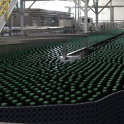|
Jo3sh posted:Yeah, we've had this come up before - there was someone who was claiming >100% pretty regularly as I recall. There's some piece of software, I forget which one, that presents an "efficiency" number which is really meta-efficiency: how efficient the mash was compared to your expected efficiency. So if that software says 100%, it's because you actually got 75% or whatever you expected to get. It certainly wasn't me! I claim a whopping 63% (which has been discussed on how to fix, just haven't brewed again yet).
|
|
|
|

|
| # ? May 21, 2024 08:34 |
wildfire1 posted:Uh what? 70% Pilsen 30% torrified wheat, 90minute mas at 64c, 240minute boil. Batch size I was aimming for: 5gallons (19l) batch I got just over (20l). At 100% efficiency I would have ended up with 1.075 (says Beersmith 2 and Brewtoad). I put it down to because it was 240minute boil (was going to be 6 hours but went with four) so I had to sparge 20.33liters extra then I normally would if I was doing 5gallon batch (I normally do 10). Freshly ordered and freshly ground malt. No kettle top water water meas pre-boil volume was 64.2 liters with quite a high evaporation rate. Post voil and cooling shrinkage brought it down to 21liters. My brewing effiency is normally around the 75-90% mark, mostly hitting the 85% area (fly sparge). Jo3sh posted:Yeah, we've had this come up before - there was someone who was claiming >100% pretty regularly as I recall. There's some piece of software, I forget which one, that presents an "efficiency" number which is really meta-efficiency: how efficient the mash was compared to your expected efficiency. So if that software says 100%, it's because you actually got 75% or whatever you expected to get. I tried it with both Beersmith 2 and Brewtoad both coming up with 100% efficinecy would make it 1.075. I am confused too and gone other the water volumes and everything, I measured everything and wrote it all down. Still the OG if 100% should have been 1.075 and I hit 1.082. Instead of topup water I did sparge, last runnings before I stopped filling up a good when I was nearing 65 liters (64.2liters I got written here) as I was getting ready for a long 6 hour boil (but went with 4 as the evaporation was getting abit OTT). I honestly don't know why and the numbers all point to it should if it was 100% (I normally hit the 85% mark but thats 90minute boil not 240minutes) it'd be 1.075 OG. I used three different hydrometers (20c ones, checked temp of it and it was at 20.4c I got written here [whenever I check beer gravity I write the temp down too) all three said 1.082. All I can put it down to is the long rear end boil? I don't know. I'm abit confused on how I got there when looking at the numbers.
|
|
|
|
|
Jacobey000 posted:His question was about how to keep brett, but drop the lacto/pedio. Get a grip. I wasn't responding to the lacto/pedio guy, I was responding to these posts: internet celebrity posted:Speaking of brett, does anyone have advice for cleaning a brett infested keg? I figure I'll boil all the small stuff, cook the dip tube in the oven, and replace the lines. The keg itself is too big for my dishwasher so I can't steam it. I'm considering filling it with boiling water and then soaking it with bleach, rinsing, and soaking with Star San. I have an expensive batch going into this keg so I really want to make sure the brett is gone. Bobsledboy posted:Don't use bleach on stainless steel, it's pretty corrosive. Use a strong pbw (or caustic) solution and rinse thoroughly with water and then starsan. Daedalus Esquire posted:I work in a sterile processing department at a hospital. If your pressure cooker runs at 15psi, you can put the metal small parts on a veggie steamer or something inside above the water. I guess make sure there is enough water to boil for about 30 minutes, I'd probably equate a pressure cooker to a gravity cycle on an autoclave. In the USA and Europe 15psi at 250° F for 30 minutes will be sterile on a gravity cycle. Which are just ridiculous. The guy asking the question thinks he needs to completely disassemble his keg, boil everything he can and bake everything else then bleach and then sanitize his keg as well as replacing his lines. Then it gets responded with that he should just boil everything once a day for several days in a row. Then a response about how he should pressure cook everything for long enough to mimic an autoclave. I am fully aware of the size of Brett and the probability of cross contamination. If you clean and sanitize your equipment properly you don't have to worry about Brett cross contaminations. This means cleaning it well with a warm soapy cleanser (pbw, dish soap, whatever) and sanitizing it properly with your choice of sanitizer. At the end of the day Brett is just yeast. Yes, it's small but it's just yeast. They aren't that hardy.
|
|
|
DontAskKant posted:How much lemongrass are you planning on? I don't know about soleras not had the pleasure of starting one yet.  But lemongrass I'm open to options, I was thinking of using 2 sticks end of boil (40 liter batch) and 2 or 4 sticks in secondary (in 20liters).
|
|
|
|
|
Fluo posted:[volumes and gravities] So did you end up short on volume to the fermenters? Remember that efficiency takes into account volume as well as SG, and that high gravity doesn't mean high efficiency if the volume is low. That is, if you were going for 20L at 1.075 and you actually ended up with 15L at 1.100, the efficiency is actually the same. Efficiency is really the measure of how much sugar you managed to extract from the grain. This sugar is dissolved in water to make wort, and the amount of water you have in the final mix will affect your SG. It goes like this: Each malt you buy will have a theoretical extract listed. I'm used to dealing with this in pounds and gallons, so please forgive the units here. A lot of base malts will have an expected extract in the area of 36 points of extract per pound of grain, per gallon of water (PPG). So if you took one pound of grain and used it to make one gallon of wort at 100% efficiency (which is not possible in a homebrew setting and would taste bad anyway), the sugar from the grain would add 36 points to the SG of the water. Since water is defined as 1.000 SG, this means that the wort would have a SG of 1.036. But it's important to realize that the same 36 points of extract, dissolved in 2 gallons of water, would have a gravity of 1.018. But again, that's theoretical yield, and you can't and don't want to make beer that way. In homebrewing, an efficiency of 75% is a pretty good benchmark, so we'd really only expect to see 3/4 of the 36 points of extract make it into the wort. In the 1 pound / 1 gallon brew, this would mean we'd only see 27 points of extract in the fermenter, so we'd have a gravity of 1.027. But then say it got boiled a little too long, and we ended up with less volume in the fermenter, ending up with only three quarts. Since water boils away but sugar doesn't, we'd see a gravity of 1.036. Even though the gravity is higher, and it kinda looks like we got every one of the 36 possible points of extract out of our grain, the efficiency is actually the same, because we have to bear in mind that we've got both 75% of the sugar AND 75% of the water we used for our pre-batch calculations in the fermenter. Can you post the actual recipe, including actual weights of grain used, and the total volume you got to the fermenter? Then I can walk through it and see what I get for numbers. Jo3sh fucked around with this message at 17:47 on Jul 3, 2014 |
|
|
|
How long will harvested yeast stay viable in the fridge? I'd heard 30 days before, but I'm past that now and wonder if this yeast is still good. Also, I've been looking into starting all-grain with the BIAB technique. Is an 8-gallon kettle large enough to brew a 5-gallon batch like this?
|
|
|
|
Luceo posted:How long will harvested yeast stay viable in the fridge? I'd heard 30 days before, but I'm past that now and wonder if this yeast is still good. Did you wash it before storage? If yes, it can last for 6+ months. If you didn't wash and the yeast is still in contact with the beer the storage time is significantly less - 30 days is probably right. You could always just try to build a starter and see how it goes. I'm sure it's probably fine. Mikey Purp fucked around with this message at 19:44 on Jul 3, 2014 |
|
|
|
Luceo posted:Also, I've been looking into starting all-grain with the BIAB technique. Is an 8-gallon kettle large enough to brew a 5-gallon batch like this? Depends on the types of beer you're looking to make. You can probably get away with a ~14 lb grain bill and still get decent efficiency from the batch with some moderate bag-squeezing but you're not going to pull off +8.5%ish abv beers without splitting the mash bill into two batches.
|
|
|
|
Mikey Purp posted:Did you wash it before storage? If yes, it can last for 6+ months. Nah it's just sitting at the bottom of a mason jar, settled out. Being that I can get yeast on brew days from the LHBS I think I'll try it with a starter the night before. wattershed posted:Depends on the types of beer you're looking to make. You can probably get away with a ~14 lb grain bill and still get decent efficiency from the batch with some moderate bag-squeezing but you're not going to pull off +8.5%ish abv beers without splitting the mash bill into two batches. Considering that my strongest beer to date is 8.5% I think I'm fine with that. I'll try a nice normal 5-6%er first and see how it goes.
|
|
|
|
Luceo posted:How long will harvested yeast stay viable in the fridge? I'd heard 30 days before, but I'm past that now and wonder if this yeast is still good. I just used a mason jar of harvested yeast that was 6 months old. I did a starter and it worked fine -- I didn't take cell counts, but the starter went well and the beer did too. edit: I should mention that I harvest yeast by making a bigger starter than I need and pouring some of it into a mason jar on brew day.
|
|
|
|
Josh Wow posted:I wasn't responding to the lacto/pedio guy, I was responding to these posts: To be fair, I never commented on whether or not he needed to or should sterilize, just gave him accurate information should he attempt it. And it's useful information should someone have an infection that is presenting difficulty to overcome with standard sanitizing procedures. I personally use tons of Brett and bugs and don't have issues in my regular beers. Doesn't mean everyone is so fortunate.
|
|
|
|
I just made my first batch of homebrew last night. However something I neglected to ask the guy at the supply store was, how do I know if I screwed up my sterilization? Is it when I die in a month, or is it pretty obvious after the fermentation?
|
|
|
|
ocrumsprug posted:I just made my first batch of homebrew last night. However something I neglected to ask the guy at the supply store was, how do I know if I screwed up my sterilization? If it tastes bad you messed it up. You won't die unless you added some kind of poison directly do it.
|
|
|
|
Jo3sh posted:Can you post the actual recipe, including actual weights of grain used, and the total volume you got to the fermenter? Then I can walk through it and see what I get for numbers. It's worth pointing out here that you shouldn't care too much about amount into fermenters, since that's brew house efficiency not mash efficiency and will vary depending on trub losses. You should be looking at pre boil volume and gravity.
|
|
|
|
ocrumsprug posted:I just made my first batch of homebrew last night. However something I neglected to ask the guy at the supply store was, how do I know if I screwed up my sterilization? First, welcome to the thread. Second, brewing has much more in common with cooking than with open-heart surgery, and people have been making alcohol since they were people - long before microbiology was understood or soap was invented. The chances of killing yourself or even becoming ill (more than "I had too many beers and now my head hurts") are nonexistent.
|
|
|
|
ocrumsprug posted:I just made my first batch of homebrew last night. However something I neglected to ask the guy at the supply store was, how do I know if I screwed up my sterilization? How and how often did you sanitize/sterilize your stuff? What did you use?
|
|
|
|
Thanks. I think the big deal sterilization was being made of in everything I had read prior was feeding my anxiety.JawKnee posted:How and how often did you sanitize/sterilize your stuff? What did you use? I used the One Step Cleaner the supply place sold me. Everything that wasn't boiling got a rinse with that before it was used. It is probably fine, I just wasn't sure what to expect if it wasn't. My primary is bubbling along quite nicely at the moment, so hopefully in a couple of weeks it will turn out well.
|
|
|
|
Josh Wow posted:Which are just ridiculous. The guy asking the question thinks he needs to completely disassemble his keg, boil everything he can and bake everything else then bleach and then sanitize his keg as well as replacing his lines. Then it gets responded with that he should just boil everything once a day for several days in a row. Then a response about how he should pressure cook everything for long enough to mimic an autoclave. If you have a spore forming Brett infection, it is good advice to boil/pressure cook multiple times to allow any spores to germinate. If someone has repeated problems with an unintentional Brett infection I fail to see the problem with telling them how to be thorough in removing it. Replacing soft parts and heat sterilising small parts is hardly a lot of effort to be sure about something. Nobody is suggesting anyone needs to do this every time.
|
|
|
Jo3sh posted:So did you end up short on volume to the fermenters? Remember that efficiency takes into account volume as well as SG, and that high gravity doesn't mean high efficiency if the volume is low. That is, if you were going for 20L at 1.075 and you actually ended up with 15L at 1.100, the efficiency is actually the same. 0.25kg Rice Hulls 3.50kg Pilsner 1.50kg Torrified Wheat 240minutes Bobek (Styrian Golding B) 3.13% 10grams 3.9IBU 90minute mash at 64c (18liters, total grain weight 5.25kg)), mash out 10minutes at 75c adding 8liters of slightly over boiling water around 98c, end of running gravity 1.009 mash ph 5.2, sparge runoff p.h 5.9. Preboil volume 64.2 liters. End of 240minutes 24liters in the kettle, transfered 21 into a 23 liter carboy. Gravity 1.082. I didn't seem to have written the preboil gravity down... I can't work out why it says 1.082 with three different hydrometers though cause heat wasn't an issue. I just don't know there must be something somewhere a reason why to explain it isn't over 100% but I can't really work out why, its hurting my head doing the maths over and over. Just pretend I didn't saything. 
|
|
|
|
|
What's with these super long boils? 90 is the most I've ever heard of and that's for pilsner malt.
|
|
|
|
Fluo posted:0.25kg Rice Hulls OK, again working in units I am used to, that's something like: 7.72 pounds @ 37 PPG, and 3.3 pounds @ 36PPG - or - 285.64 points of theoretical extract, plus 118.8 points ----- 404.44 total points of theoretical extract (and again, this is not possible or desirable in a homebrew setting). in 21L or 5.55 gallons of wort to the fermenters, this ought to make a gravity of 1.073 (1.07287+) at 100% efficiency. At 75% eff., I'd expect more like 1.055. So at this point I have to say, without having been there, that some measurement or other is likely hosed. Either you used more grain than you thought you did, you transferred less wort to fermenters than you thought, all three of your hydrometers are hosed, or your thermometer is seriously hosed. As you describe it, though, you did indeed get >100% efficiency. Did you add any kettle sugars or any kind? Did you add top-up water that might not have been mixed into the wort well? Has there been a gravitational anomaly in your neighborhood?
|
|
|
|
If you have access to a refractometer, you can use that + FG measured by the hydrometer to see what your og was.
|
|
|
Jo3sh posted:OK, again working in units I am used to, that's something like: Yeah I really think it has to be one of these but it can't be because I'm anal about measuring. But it just drat has to be and I hosed up somewhere, I didn't add any sugars or topup water. I just over sparged the grain. All I can think logically that I did was because I'm use to doing 40liter batches and not 21ish liter batches I put double the grain and so boiled it down for 4 hours to 21liters in fermenter volume. But I must have had the biggest brainfart ever. I don't think I did but it doesn't add up otherwise.  Only other thing I can think of which would be more realistic as I normally hit 8x% is when weighting the grain I didn't reset the scales so ended up putting an extra kg of torrified wheat or pilsen. It's one of those things where everything I written down says one thing but it just can't be. Lets just go with I didn't reset the scales and ended up with abit more of either malt!  Lambic is going crazy at the moment, I love his point in fermenting cause it's the point is feels the most alive / its a living thing.  https://vine.co/v/MU5jwAOl0Bn https://vine.co/v/MU5jwAOl0BnFluo fucked around with this message at 11:17 on Jul 4, 2014 |
|
|
|
DontAskKant posted:What's with these super long boils? 90 is the most I've ever heard of and that's for pilsner malt. Lambic!  Because I used torrified wheat instead of plain unmalted white wheat I didn't really have to do a turbin mash but will do one in future. http://www.themadfermentationist.com/2008/09/brewing-lambic-20.html (I recommend themanfermentationist's book American Sour Beers aswell as WildBrews if you're interested in sours)! 
|
|
|
|
|
DontAskKant posted:What's with these super long boils? 90 is the most I've ever heard of and that's for pilsner malt. I dunno about lambic, but apparently it's a thing for some dark and heavy beers, and scotch ales (one method is to take the first runnings and boil/cook to a dark syrup)
|
|
|
|
In radical brewing (I think), Mosher suggests that an extended boil can be used as a simple replacement for single decoctions. The long boil increases the caramelization of malt sugars allow a stroner malt backbone in beers and an increase in the darkness of the beer.
|
|
|
|
Fluo posted:Lets just go with I didn't reset the scales and ended up with abit more of either malt! I think that's the most likely, too. Working backwards... 5.55 gallons at 1.082 would mean 455 points of extract into the fermenter. At ~85% efficiency, that would mean 535 points of theoretical extract, or 14.66 pounds (6.66 kilos) of grain. Could you have weighed the torrified wheat in twice somehow? Daedalus Esquire posted:In radical brewing (I think), Mosher suggests that an extended boil can be used as a simple replacement for single decoctions. The long boil increases the caramelization of malt sugars allow a stroner malt backbone in beers and an increase in the darkness of the beer. I've done a barleywine that way. I collected 13 gallons of runnings and then boiled it all down to make a five-gallon batch. It was really good beer, with a big malt backbone, although I wouldn't really call it carameley. It was definitely darker for the boil. Jo3sh fucked around with this message at 17:13 on Jul 4, 2014 |
|
|
Jo3sh posted:I think that's the most likely, too. Yeah it must have been something along these lines, the sparging washn't hard but I put that down to the rice hulls. Something must have gave me a brainfart because otherwise it broke some kind of physics. Hopefully the lambic will turn out fine, if I do another one I will be more anal about the weight, aim for 1.040 og and maybe transfer a gallon from one to the other. I dreaded going over because of the fear of the bacteria / lambic draggs I added being useless I must have hosed up somewhere, hopefully in time I'll be able to fix the lambic etc. 
|
|
|
|
|
Is there any truth to the idea that dry yeast doesn't really need oxygenation like liquid yeast? I'm finding different answers everywhere.
|
|
|
|
Just finished brewing my first all grain batch of my hopped up wheat beer. Man, whoever said that wheats aren't the best one to start off with was right. I had an immediate stuck sparge when I opened my ball valve. Part of that was because I should have gone with my gut and used the full pound of rice hulls and part of it was because I definitely should have started with hotter water, or pre-warmed the cooler a bit because by the time my mash was done I was down to 145. I also hit a snag because I started pouring in heavy wind and I had to move my burner out of the rain which took a few minutes. After adding some of my sparge water and vigorous stirring I got it to budge for a few seconds, but then it slowed right up again. After trying that a couple more times and getting nowhere, I dumped my sparge water back into the kettle and dumped the whole mash into my HLT and ran some water through the mash tun. I then dumped it all back in and by the grace of the beer gods, it opened up. I used the rest of my hot water for a fly sparge and was on my way. Despite the serious temp drop and all the crap I had to do to get it going. I wasn't really far off on my target efficiency. I was aiming for 1.046 OG assuming 75% and hit around 1.042. That'll knock the beer down a smidge in ABV, but overall, I'm happy I was able to get that close to my goal given the huge problems I was having.
|
|
|
|
internet celebrity posted:Is there any truth to the idea that dry yeast doesn't really need oxygenation like liquid yeast? I'm finding different answers everywhere. Nope they need o2 just like liquid. Yeast need o2 to build cell walls which they will be doing a lot of when reproducing to ferment the wort. This is something liquid and dry will need since you're not going to pitch either in the amounts to where they won't need to reproduce to fully ferment the wort
|
|
|
|
Welp, I just had my first mini explosion! Woke up this morning to find that my lemongrass kölsch that was brewed yesterday had blown the lid off the primary and spilled thankfully just a tiny bit of krausen on the floor. I'm reading that the batch should pull through since the fermentation is so vigorous, but is there anything I need to do other than clean/sterilize the lid and airlock again and pop em back on? I think I might have gone a little overboard with the fill level since my last two beers have had a really low yield, for what it's worth. vvv Thanks, I ended up setting up a rig like you suggested. This thing is bubbling a lot harder than my previous two! Millions fucked around with this message at 20:59 on Jul 5, 2014 |
|
|
|
Just resanitize and reassemble. But you might consider setting up some kind of blowoff rig rather than the airlock, at least until the ferment tapers off.
|
|
|
|
My first all grain, a berliner using a sour mash method, was a huge success. Today I'm brewing another batch of it with a few changes: -Actually figuring out my efficiency (It's only 62%... eek) -Using White Labs Lacto instead of Acid Malt (will hold the temperature at 110 degrees until it sours to me liking, hopefully a few days. Will probably throw in some acid malt as well just in case) -After it's sour enough to my liking, I plan on throwing in some White Labs Brett Also picked some wild blackberries and bought some red currants and gooseberries from the farmers market....
|
|
|
|
Is White Labs still doing that vial redemption program? I emailed them to ask and got nothing back. I have enough for what would be 2 of the beer books, if it was still going on.
|
|
|
|
Their site says so: http://www.whitelabs.com/customerclub
|
|
|
|
Jo3sh posted:Their site says so: Well sure, the Internet says so, but these are things I want to check before throwing a bunch of yeast vials in a box and mailing it 2,000 miles. The fact they didn't write back when they asked has made me unreasonably paranoid about it.
|
|
|
|
They updated the site when they went to the new packaging. That seems to me like they are still doing it. Which is good, because I'm saving up for a sweatshirt.The Site posted:(Please note: Customer club redemptions will remain the same regardless if one is redeeming traditional vial or PurePitch).
|
|
|
|
Just went strawberry picking and started a batch of strawberry wine using wyeast forbidden fruit with an OG of .070. I'm curious how this will come out. I've added nutrient, had the strawberries sitting in sulfite and pectin enzyme, and had to add a good chunk of sugar to get to that OG. Wyeasts website said that this strain can tolerate up to 11%, so I'm hoping I can bottle condition it with more sugar to make strawberry bubbly.
|
|
|
|

|
| # ? May 21, 2024 08:34 |
|
For the White Labs redemption you don't have to mail in the tube, just the label.
|
|
|
































